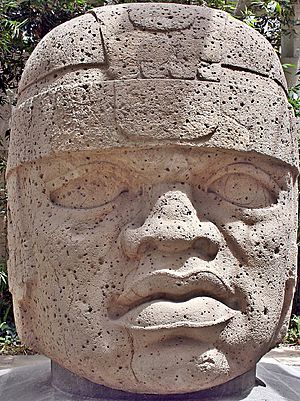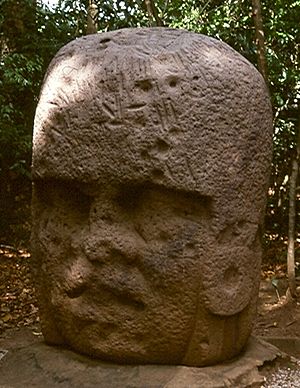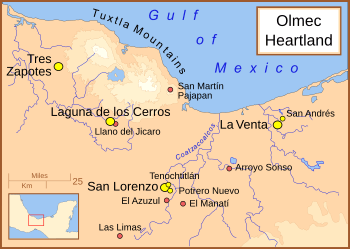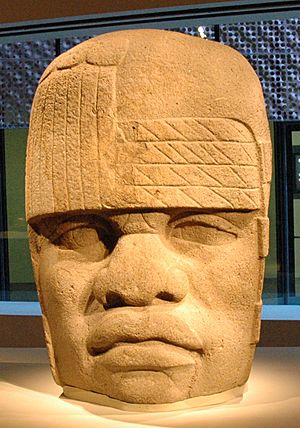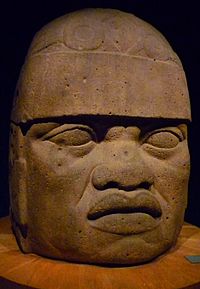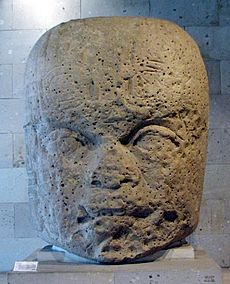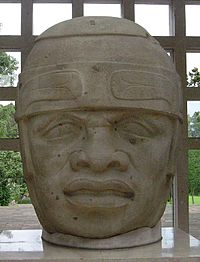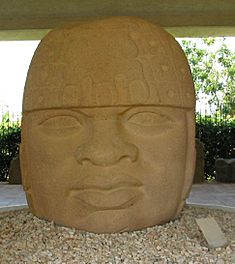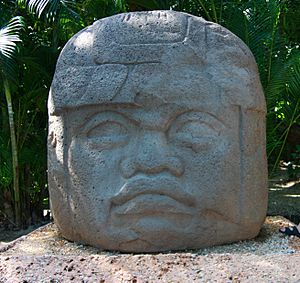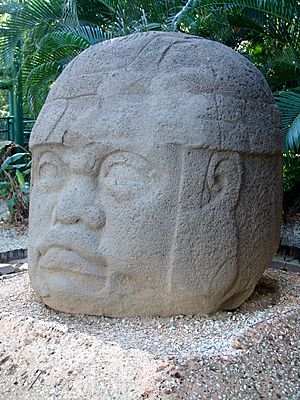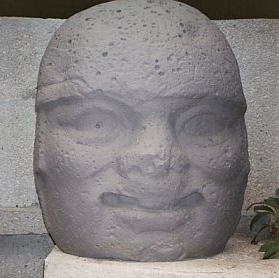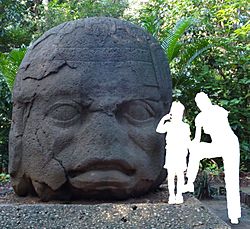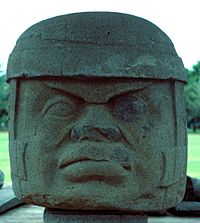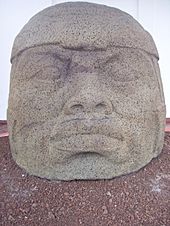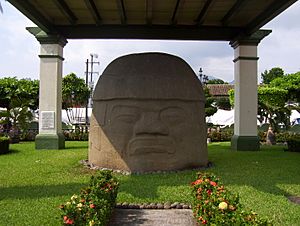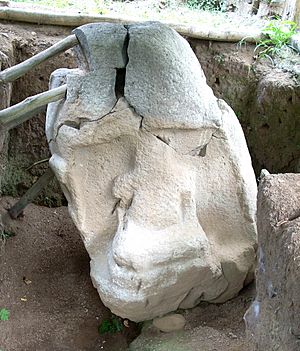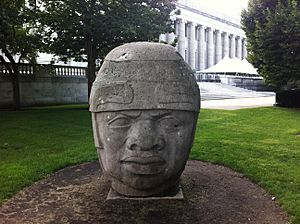Olmec colossal heads facts for kids
The Olmec colossal heads are huge stone sculptures of human heads. They were carved by the ancient Olmec civilization in Mesoamerica. These amazing heads are made from large basalt rocks and stand between 1.17 and 3.4 meters (about 4 to 11 feet) tall.
These heads are very old, dating back to at least 900 BC. They are a special part of the Olmec civilization. All the heads show grown-up people with full cheeks, flat noses, and slightly crossed eyes. Their faces look like people who still live in the Tabasco and Veracruz areas of Mexico today. The backs of the heads are often flat.
The giant stones used for these sculptures came from the Sierra de Los Tuxtlas mountains in Veracruz. Moving these huge rocks over long distances (more than 150 kilometers or 93 miles) took a lot of effort and resources. Because of this, many experts believe the heads are portraits of powerful Olmec rulers. Each head has a unique headdress. The heads were placed in lines or groups in important Olmec cities. We still don't know exactly how they moved these massive stones. The headdresses might have been protective helmets for war or for playing the Mesoamerican ball game.
The first colossal head was found in Tres Zapotes in 1862 by José María Melgar y Serrano. But it wasn't until Matthew Stirling excavated the same head in 1938 that archaeologists really started to study the Olmec culture. So far, 17 confirmed heads have been found at four sites in the Olmec heartland on the Gulf Coast of Mexico. Most heads were carved from round boulders. However, two from San Lorenzo Tenochtitlán were actually re-carved from huge stone thrones. There's also a possible head at Takalik Abaj in Guatemala, which is a throne that might have been made from a colossal head. This is the only known example found outside the Olmec heartland.
It's hard to know the exact age of the heads because many were moved from their original spots before archaeologists could study them. Most are thought to be from the Early Preclassic period (1500–1000 BC). Some are from the Middle Preclassic (1000–400 BC). The smallest heads weigh 6 tons, while the largest is estimated to weigh 40 to 50 tons.
Contents
The Olmec Civilization
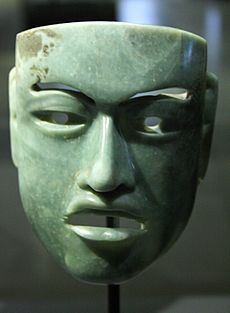
The Olmec civilization grew in the lowlands of southeastern Mexico between 1500 and 400 BC. The main Olmec area, called the Olmec heartland, is on the Gulf Coast of Mexico. It covers parts of Veracruz and Tabasco. This area is about 275 kilometers (170 miles) wide and stretches about 100 kilometers (62 miles) inland from the coast.
The Olmecs are seen as the first major civilization to develop in Mesoamerica. Their heartland is one of only six places in the world where civilizations first began. What makes the Olmecs special is that their civilization grew in a tropical forest environment.
The Olmecs were among the first people in the Americas to build large structures and live in towns and cities. They were also the first to create amazing stone sculptures. In the early 2000s, scientists found evidence of Olmec writing, with the oldest examples dating to around 650 BC. These writings are short and have been partly understood because they are similar to other Mesoamerican scripts. Because of their complex society, the Olmecs are often called the "Mother Culture" of Mesoamerica.
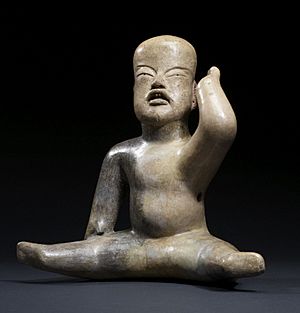
Some Olmec rulers might have also had religious roles. The city of San Lorenzo was the main center of the civilization until about 900 BC, when La Venta took over. Tres Zapotes and Laguna de los Cerros might have also been important centers. Olmec art is very detailed and beautiful, especially the Olmec figurines and larger sculptures like The Wrestler. Many pottery figurines have been found, suggesting they were widely available. Stone "Olmec-style masks" are also important because they look similar to the colossal heads. Most Olmec monumental sculptures show human forms, and the colossal heads are a big part of this.
How Old Are the Heads?
It's hard to know the exact dates for the colossal heads. However, the heads from San Lorenzo were buried by 900 BC, which means they were made and used even earlier. The heads from Tres Zapotes had been moved before archaeologists studied them. The heads from La Venta were found partly uncovered on the ground. So, we don't know exactly how long it took to make all the heads, or if it was over a century or a thousand years. Estimates range from 50 to 200 years. The San Lorenzo heads are thought to be the oldest and are very well made. All the stone heads are from the Preclassic period of Mesoamerican chronology, mostly the Early Preclassic (1500–1000 BC). The two Tres Zapotes heads and the La Cobata Head are from the Middle Preclassic (1000–400 BC).
What the Heads Look Like
Olmec colossal heads are between 1.47 and 3.4 meters (about 5 to 11 feet) tall and weigh from 6 to 50 tons. All of them show mature men with flat noses and full cheeks. Their eyes often look slightly crossed. These features are still common among people living in the Olmec region today. The backs of the heads are often flat, as if they were meant to be placed against a wall.
All the Olmec colossal heads wear special headdresses. These probably looked like cloth or animal hides in real life. Some have a knot tied at the back, and some are decorated with feathers. One head from La Venta even has a bird's head on it. Similarities in the headdresses suggest they might represent different ruling families or specific rulers. Most heads also wear large earspools in their earlobes.
All the heads look very real and unique, not like perfect, idealized figures. It's likely they were portraits of actual rulers who were alive (or had recently passed away) and known to the sculptors. Each head is different and natural, showing individual features. People once thought they represented ballplayers, but this idea isn't widely accepted anymore. However, it's possible they show rulers dressed for the Mesoamerican ball game. The faces show different expressions, from serious to calm to smiling. The earliest Olmec art looks the most realistic, appearing suddenly without earlier examples. Over time, the sculptures became more stylized. Wooden sculptures found at El Manatí suggest the Olmecs probably made many more sculptures from wood, which didn't survive as well as stone.
Some people in the late 1800s and 1900s suggested the Olmecs had African origins because of the features on the heads. However, modern genetic studies show that the earliest Americans came from Asia, not Africa. These ideas are not supported by scientific research.
Even though all the colossal heads are similar, they have different artistic styles. One head from San Lorenzo still has traces of plaster and red paint, meaning the heads were originally brightly colored. The heads didn't just show individual rulers; they also represented the very idea of leadership itself.
How They Were Made
Making each colossal head required careful planning. It took a lot of effort and resources, so only the most powerful Olmec rulers could likely organize such a project. The team would have included sculptors, laborers, supervisors, boatmen, woodworkers, and other craftspeople who made the tools for carving and moving the monuments. They also needed people to feed and care for all these workers. The Olmecs had to consider the seasons, farming cycles, and river levels to plan the project. The whole process could have taken years.
Archaeologists have studied Olmec basalt workshops. They believe the colossal heads were first roughly shaped by hitting the stone to chip off large and small pieces. Then, the sculpture was made smoother by using hammerstones, which were usually round stones, sometimes made of the same basalt. Abrasives (materials for grinding) found at San Lorenzo workshops show they were used for fine details. Olmec colossal heads were carved in a way that some parts stood out more than others. The face usually had higher relief, while the earspools and headdresses had lower relief. One monument at San Lorenzo, Monument 20, is a damaged throne that might have been in the process of being re-carved into a colossal head but was never finished.
All 17 confirmed heads in the Olmec heartland were carved from basalt rock found in the Sierra de los Tuxtlas mountains of Veracruz. Most were made from a dark-grey basalt called Cerro Cintepec basalt, named after a volcano in the area. Scientists think the large Cerro Cintepec basalt boulders found on the mountains' southeastern slopes were the source of the stone. These boulders are in an area affected by large lahars (volcanic mudslides), which carried big blocks of stone down the mountain. This means the Olmecs didn't have to quarry the stone; they could pick up already-detached boulders. They carefully chose round boulders that looked like human heads. The stone for the San Lorenzo and La Venta heads was transported a long way from its source. The La Cobata head was found on El Vigia hill in the Sierra de los Tuxtlas. The stone for Tres Zapotes Colossal Head 1 and Nestepe Colossal Head 1 also came from the same hill.
The boulders were transported over 150 kilometers (93 miles) from where they were found. We don't know the exact method for moving such huge rocks. The Olmecs didn't have animals to carry loads or working wheels. They probably used water transport whenever they could. However, moving monuments weighing 20 tons or more by water might have been difficult due to coastal currents and river conditions. Two damaged Olmec sculptures show rectangular stone blocks tied with ropes. A human figure is riding on each block. These sculptures might show Olmec rulers watching over the transport of the stone that would become their monuments. When they had to move the heads over land, the Olmecs likely used raised paths, ramps, and roads. The area has swamps and floodplains, which were big challenges. Building temporary raised paths using the plentiful floodplain soils would have allowed a direct route across these areas to the San Lorenzo Plateau. The Olmecs built large Earth structures like mounds and platforms, showing they knew how to build big earthworks and had the resources to do so.
The flat backs of many colossal heads suggest they were re-carved from monumental thrones that had flat bases. Only four of the 17 heads don't have flattened backs, which means most might have been reworked from earlier monuments. Another idea is that the backs were flattened to make them easier to transport, providing a stable shape for pulling the monuments with ropes. Two heads from San Lorenzo have traces of niches, which are typical of Olmec thrones. This strongly suggests they were indeed re-carved from older monuments.
| Site name | Location | Monument | Alternative name | Height | Width | Depth | Weight (tons) |
|---|---|---|---|---|---|---|---|
| San Lorenzo | Veracruz | Colossal Head 1 | Monument 1 | 2.84 metres (9.3 ft) | 2.11 metres (6.9 ft) | 25.3 | |
| San Lorenzo | Veracruz | Colossal Head 2 | Monument 2 | 2.69 metres (8.8 ft) | 1.83 metres (6.0 ft) | 1.05 metres (3.4 ft) | 20 |
| San Lorenzo | Veracruz | Colossal Head 3 | Monument 3 | 1.78 metres (5.8 ft) | 1.63 metres (5.3 ft) | 0.95 metres (3.1 ft) | 9.4 |
| San Lorenzo | Veracruz | Colossal Head 4 | Monument 4 | 1.78 metres (5.8 ft) | 1.17 metres (3.8 ft) | 0.95 metres (3.1 ft) | 6 |
| San Lorenzo | Veracruz | Colossal Head 5 | Monument 5 | 1.86 metres (6.1 ft) | 1.47 metres (4.8 ft) | 1.15 metres (3.8 ft) | 11.6 |
| San Lorenzo | Veracruz | Colossal Head 6 | Monument 17 | 1.67 metres (5.5 ft) | 1.41 metres (4.6 ft) | 1.26 metres (4.1 ft) | 8–10 |
| San Lorenzo | Veracruz | Colossal Head 7 | Monument 53 | 2.7 metres (8.9 ft) | 1.85 metres (6.1 ft) | 1.35 metres (4.4 ft) | 18 |
| San Lorenzo | Veracruz | Colossal Head 8 | Monument 61 | 2.2 metres (7.2 ft) | 1.65 metres (5.4 ft) | 1.6 metres (5.2 ft) | 13 |
| San Lorenzo | Veracruz | Colossal Head 9 | Monument 66 | 1.65 metres (5.4 ft) | 1.36 metres (4.5 ft) | 1.17 metres (3.8 ft) | |
| San Lorenzo | Veracruz | Colossal Head 10 | Monument 89 | 1.8 metres (5.9 ft) | 1.43 metres (4.7 ft) | 0.92 metres (3.0 ft) | 8 |
| La Venta | Tabasco | Monument 1 | 2.41 metres (7.9 ft) | 2.08 metres (6.8 ft) | 1.95 metres (6.4 ft) | 24 | |
| La Venta | Tabasco | Monument 2 | 1.63 metres (5.3 ft) | 1.35 metres (4.4 ft) | 0.98 metres (3.2 ft) | 11.8 | |
| La Venta | Tabasco | Monument 3 | 1.98 metres (6.5 ft) | 1.6 metres (5.2 ft) | 1 metre (3.3 ft) | 12.8 | |
| La Venta | Tabasco | Monument 4 | 2.26 metres (7.4 ft) | 1.98 metres (6.5 ft) | 1.86 metres (6.1 ft) | 19.8 | |
| Tres Zapotes | Veracruz | Monument A | Colossal Head 1 | 1.47 metres (4.8 ft) | 1.5 metres (4.9 ft) | 1.45 metres (4.8 ft) | 7.8 |
| Tres Zapotes | Veracruz | Monument Q | Colossal Head 2, Nestape Head | 1.45 metres (4.8 ft) | 1.34 metres (4.4 ft) | 1.26 metres (4.1 ft) | 8.5 |
| La Cobata | Veracruz | La Cobata Head | 3.4 metres (11 ft) | 3 metres (9.8 ft) | 3 metres (9.8 ft) | 40 | |
| Takalik Abaj | Retalhuleu | Monument 23 | 1.84 metres (6.0 ft) | 1.2 metres (3.9 ft) | 1.56 metres (5.1 ft) |
Where the Heads Are Found
Seventeen confirmed colossal heads are known. An additional monument at Takalik Abaj in Guatemala is a throne that might have been carved from a colossal head. This is the only possible example found outside the Olmec heartland on the Gulf Coast of Mexico. Some possible pieces of other colossal heads have been found at San Lorenzo and San Fernando in Tabasco. There are also rough colossal stone heads in the Southern Maya area that look like the potbelly style. While some think these are older than the Olmecs, most believe they were influenced by the Olmec style.
| Site | Number of Heads |
|---|---|
| San Lorenzo Tenochtitlán | 10 |
| La Venta | 4 |
| Tres Zapotes | 2 |
| La Cobata | 1 |
| Takalik Abaj | 1 (possible) |
San Lorenzo Heads
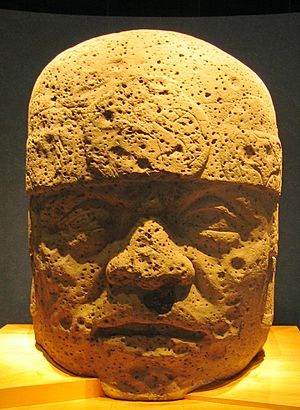
The ten colossal heads from San Lorenzo were originally arranged in two lines. They were found close to their first locations, even though some had fallen into ravines. These heads, along with stone thrones, probably formed a special path through the site, showing off the history of their rulers. Two of the San Lorenzo heads were re-carved from older thrones.
San Lorenzo Colossal Head 1 was found facing upwards. It's 2.84 meters (9.3 feet) high and weighs 25.3 tons. It was discovered by Matthew Stirling in 1945. This head has a plain band on its headdress with a U-shaped design. The face has a frown and slightly parted lips. It's now at the Museo de Antropología de Xalapa.
San Lorenzo Colossal Head 2 was made from an old throne. It's 2.69 meters (8.8 feet) high and weighs 20 tons. Matthew Stirling found it in 1945. This head wears a complex headdress with three bird's heads. The face looks like an older man with a frown and thick lips. It's now in the Museo Nacional de Antropología in Mexico City.
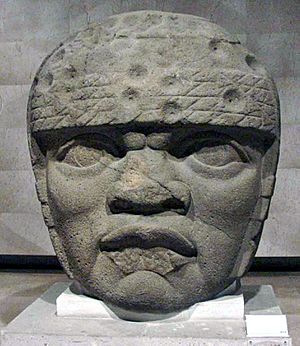
San Lorenzo Colossal Head 3 is 1.78 meters (5.8 feet) high and weighs 9.4 tons. Matthew Stirling found it in a gully in 1946. It has a complex headdress with four cords and a small skullcap. The face has a frowning brow and clear eyelids. It's also at the Museo de Antropología de Xalapa.
San Lorenzo Colossal Head 4 weighs 6 tons and is 1.78 meters (5.8 feet) high. Matthew Stirling discovered it in 1946. Its headdress has four sculpted cords and tassels that look like hair. The face is that of an older man with wrinkles and a prominent chin. This head is also at the Museo de Antropología de Xalapa.
San Lorenzo Colossal Head 5 is 1.86 meters (6.1 feet) high and weighs 11.6 tons. Matthew Stirling found it in 1946. It's very well made and has jaguar paw designs on its headdress (though some think they are bird claws). The face shows an older man with wrinkles. It's now at the Museo de Antropología de Xalapa.
San Lorenzo Colossal Head 6 is one of the smaller heads, at 1.67 meters (5.5 feet) tall, weighing 8 to 10 tons. It was found in 1965. It has a net-like head covering with sculpted beads. The face is that of an aging man with a frown and wrinkles. It's now in the Museo Nacional de Antropología in Mexico City.
San Lorenzo Colossal Head 7 is 2.7 meters (8.9 feet) high and weighs 18 tons. It was re-carved from a throne. Its headdress has human hands and a feathered ornament. The face has deep-set eyes and an open mouth showing teeth. It's now at the Museo de Antropología de Xalapa.
San Lorenzo Colossal Head 8 is 2.2 meters (7.2 feet) high and weighs 13 tons. It's considered one of the best examples of an Olmec head. Its headdress is decorated with the claws of a jaguar or eagle. The face is that of a mature man with a frown. It's very well preserved and is at the Museo de Antropología de Xalapa.
San Lorenzo Colossal Head 9 is 1.65 meters (5.4 feet) high. It was found in 1982. Its headdress is a single piece, possibly showing long hair. The face is smiling with wide eyes and sagging cheeks. It's now at the Museo de Antropología de Xalapa.
San Lorenzo Colossal Head 10 is 1.8 meters (5.9 feet) tall and weighs 8 tons. It was found in 1994. Its headdress is covered with 92 circular beads and has a large element above the forehead that looks like a bird's foot. The face is that of a mature man with a closed mouth and a strong chin. It's at the Museo Comunitario de San Lorenzo Tenochtitlán.
La Venta Heads
Three of the La Venta heads were found in a line, facing north. The fourth head was found in a different area. The first La Venta head was discovered in 1925. The other three were found in 1940 when a local boy led Matthew Stirling to them.
La Venta Monument 1 is thought to be a portrait of La Venta's last ruler. It's 2.41 meters (7.9 feet) high and weighs 24 tons. Its headdress has three animal claw or fang motifs. The face shows a mature man with wrinkles. It's the best preserved head at La Venta and is now at the Parque-Museo La Venta in Villahermosa.
La Venta Monument 2 is 1.63 meters (5.3 feet) high and weighs 11.8 tons. The face has a smiling expression showing four upper teeth. It's badly eroded, and parts of its nose and upper lip were damaged on purpose. It's now at the Museo del Estado de Tabasco in Villahermosa.
La Venta Monument 3 is 1.98 meters (6.5 feet) high and weighs 12.8 tons. It was found near Monument 2 and is now at the Parque-Museo La Venta. It seems unfinished and is very damaged by weather. It had a large headdress, but details are lost.
La Venta Monument 4 is 2.26 meters (7.4 feet) high and weighs 19.8 tons. It was found near Monument 2 and is also at the Parque-Museo La Venta. Its headdress is detailed, with three horizontal strips and a bird's claw. The face shows a frown and prominent teeth.
Tres Zapotes Heads
The two heads at Tres Zapotes, along with the La Cobata head, look different from the others. Some experts think they are a later, local style. These heads have simpler headdresses, are wide, and have unique facial features. The discovery of one of these heads in the 1800s led to the first archaeological studies of the Olmec culture.
Tres Zapotes Monument A was the first colossal head ever found, discovered by accident in the mid-1800s. It's 1.47 meters (4.8 feet) tall and weighs 7.8 tons. It has a simple headdress and rectangular ear ornaments. The face has deep creases and a frown. It's now at the Museo Comunitario de Tres Zapotes.
Tres Zapotes Monument Q is 1.45 meters (4.8 feet) high and weighs 8.5 tons. It was found in the 1940s. Its headdress has a tongue-shaped ornament and seven braids of hair at the back. The face has strong creases around the nose, mouth, and eyes. It's now in the plaza of Santiago Tuxtla.
La Cobata Head
The La Cobata region was where the basalt stone for all the Olmec colossal heads came from. The La Cobata colossal head was found in 1970 in a mountain pass near Santiago Tuxtla. It was mostly buried. It's believed to have been left there long after it was carved. The La Cobata head has been moved to the main plaza at Santiago.
The La Cobata head is mostly round and measures about 3 meters (9.8 feet) wide by 3.4 meters (11.2 feet) high, making it the largest known head. This huge sculpture is estimated to weigh 40 tons. It looks different from the other heads. Some researchers think it represents a person who has passed away. Others believe its unique style is because it was never finished. The eyes are closed, the nose is flat, and the mouth isn't carved realistically. The headdress is a plain band.
The original spot where the La Cobata head was found wasn't a major Olmec city. It was probably abandoned at its source or while being moved to its planned location. Many features suggest it was unfinished, like its lack of symmetry and rough stone areas. It was almost certainly carved from a raw boulder, not from an old throne.
Takalik Abaj Head
Takalik Abaj Monument 23 is from the Middle Preclassic period. It's found in Takalik Abaj, an important city in Guatemala. It appears to be an Olmec-style colossal head that was re-carved into a different type of sculpture. If it was originally a colossal head, it would be the only one found outside the Olmec heartland.
Monument 23 is made from andesite stone and is a medium size for a colossal head. It's 1.84 meters (6 feet) high. Like the heads from the Olmec heartland, it has a flat back. Some experts disagree on whether it was truly a re-carved colossal head. It was damaged in the mid-1900s by a local stonemason, but the broken pieces have been put back together by archaeologists.
Where to See the Heads
All 17 confirmed colossal heads are still in Mexico.
- Two heads from San Lorenzo are on display at the Museo Nacional de Antropología in Mexico City.
- Seven San Lorenzo heads are at the Museo de Antropología de Xalapa.
- The remaining San Lorenzo head is at the Museo Comunitario de San Lorenzo Tenochtitlán.
- All four heads from La Venta are now in Villahermosa, Tabasco. Three are at the Parque-Museo La Venta, and one is at the Museo del Estado de Tabasco.
- Two heads are in the plaza of Santiago Tuxtla: one from Tres Zapotes and the La Cobata Head.
- The other Tres Zapotes head is at the Museo Comunitario de Tres Zapotes.
Several colossal heads have traveled for temporary exhibitions in other countries. For example, San Lorenzo Colossal Head 6 went to the Metropolitan Museum of Art in New York in 1970. San Lorenzo heads 4 and 8 were shown at the National Gallery of Art in Washington, D.C., in 1996. San Lorenzo heads 5 and 9 were part of an exhibition at the de Young Museum in San Francisco in 2011.
Protecting the Heads
On January 12, 2009, some people entered the Parque-Museo La Venta in Villahermosa and damaged almost 30 ancient pieces, including the four La Venta colossal heads. The people involved were part of a religious group and seemed to be performing a ritual, throwing salts, grape juice, and oil on the heads. It cost a lot of money to repair the damage, and the restoration took four months. The people who caused the damage were released after paying a large fine.
Copies Around the World
Many copies of the Olmec heads have been placed around the world, often thanks to Miguel Alemán Velasco, a former governor of Veracruz. Here are some places where you can find replicas in the United States:
- Austin, Texas: A copy of San Lorenzo Head 1 was placed at the University of Texas at Austin in 2008.
- Chicago, Illinois: A copy of San Lorenzo Head 8 was placed at the Field Museum of Natural History in 2000.
- Covina, California: A copy of San Lorenzo Head 5 was given to Covina in 1989 and is now in Jobe's Glen, Jalapa Park.
- McAllen, Texas: A copy of San Lorenzo Head 8 is at the International Museum of Art & Science.
- New York: A copy of San Lorenzo Head 1 is at Lehman College in the Bronx.
- Paris, France: Since 2013, the Musée du Quai Branly – Jacques Chirac has displayed a copy of San Lorenzo Head 8.
- San Francisco, California: A copy of San Lorenzo Head 1 was placed at San Francisco City College in 2004.
- Washington, D.C.: A copy of San Lorenzo Head 4 is near the entrance of the Smithsonian National Museum of Natural History.
- West Valley City, Utah: A copy of San Lorenzo Head 8 was placed at the Utah Cultural Celebration Center in 2004.
- Todos Santos, Baja Sur, Mexico: A copy of San Lorenzo Head 8 was sculpted in 2018.
Mexico also donated a resin copy of an Olmec colossal head to Belgium, which is displayed at the Art & History Museum in Brussels.
In 2010, Mexico's government announced it would donate a copy of an Olmec colossal head to Ethiopia. It was placed in Plaza Mexico in Addis Ababa and is known locally as the "Mexican Warrior."
In 2017, Mexican President Enrique Peña Nieto donated a full-size copy of San Lorenzo Head 8 to the people of Belize. It was installed in Belmopan.
Images for kids
-
San Lorenzo Colossal Head 4, now at the Museo de Antropología de Xalapa
See also
 In Spanish: Cabeza colosal para niños
In Spanish: Cabeza colosal para niños


